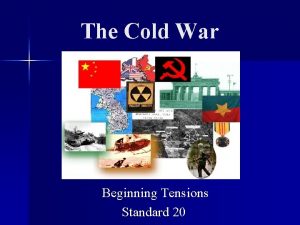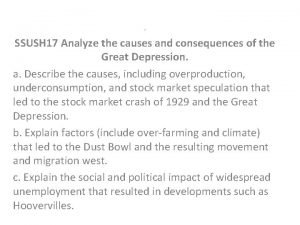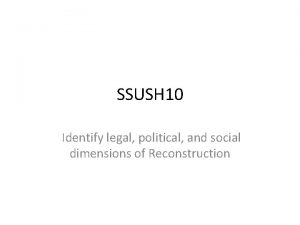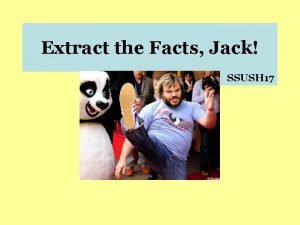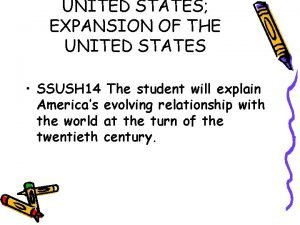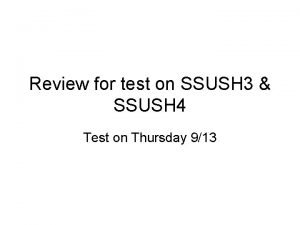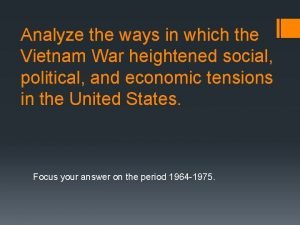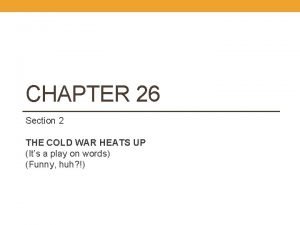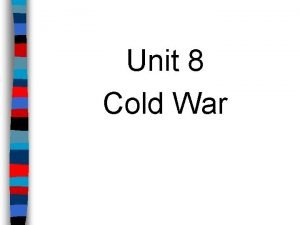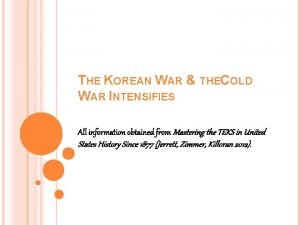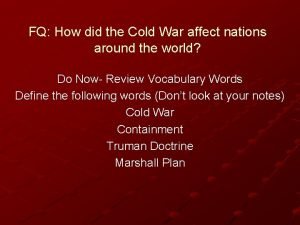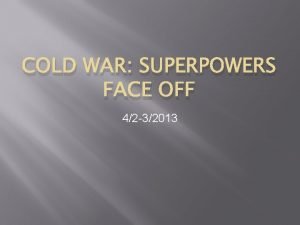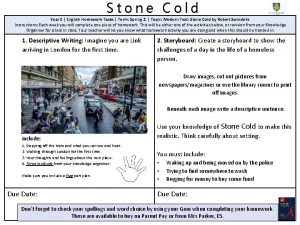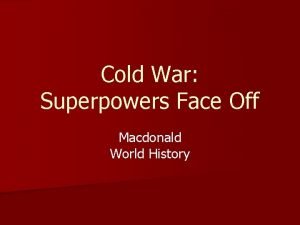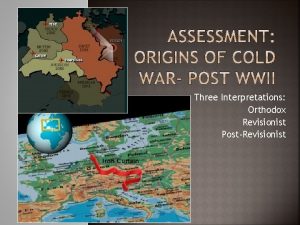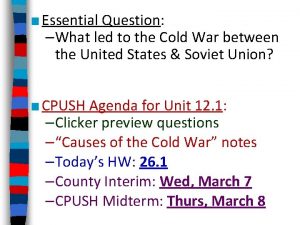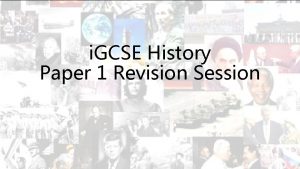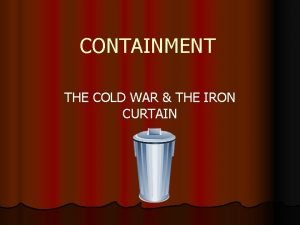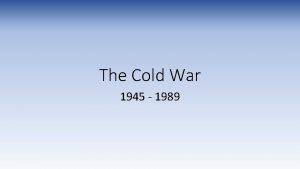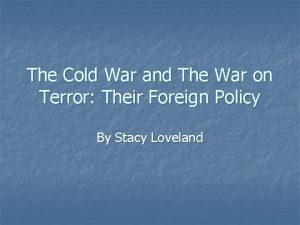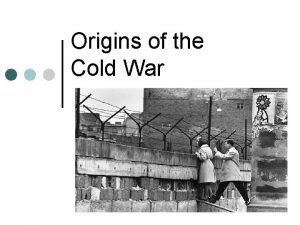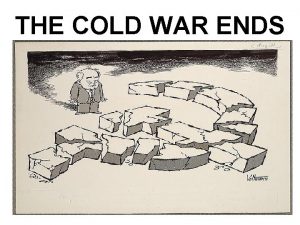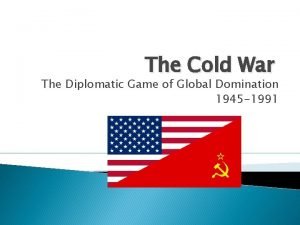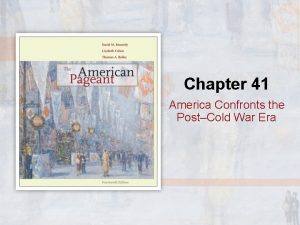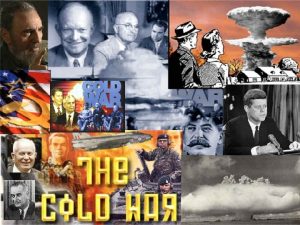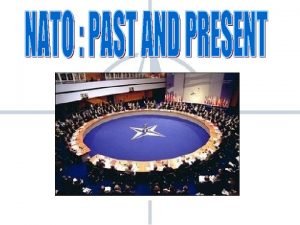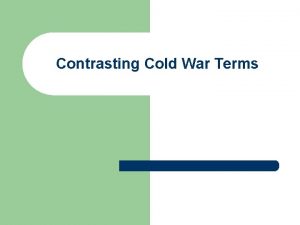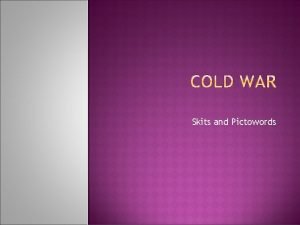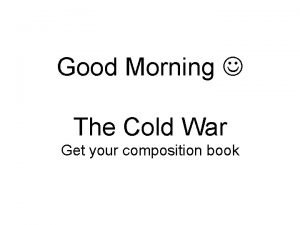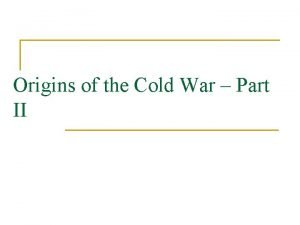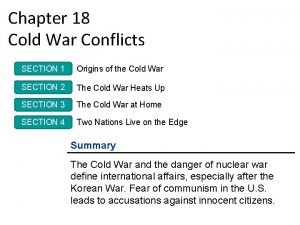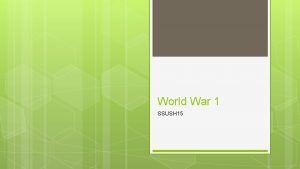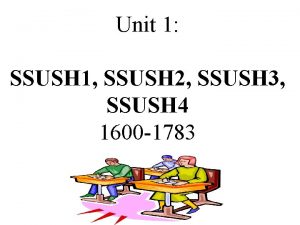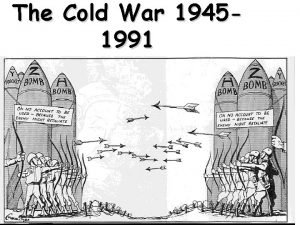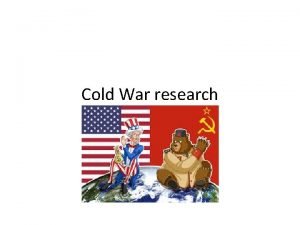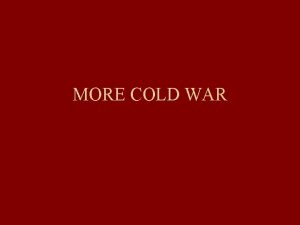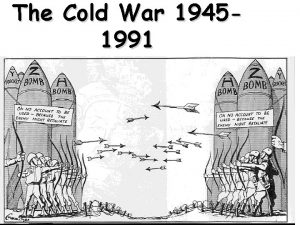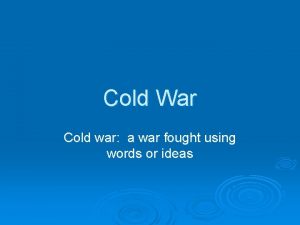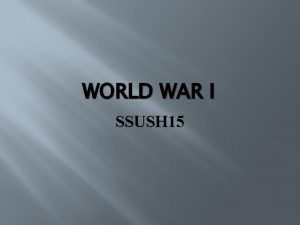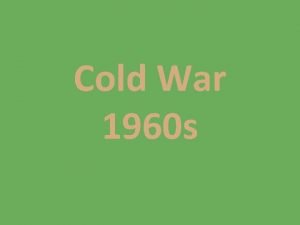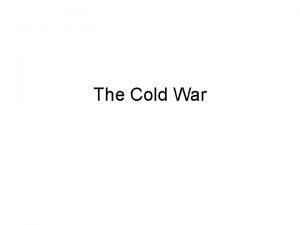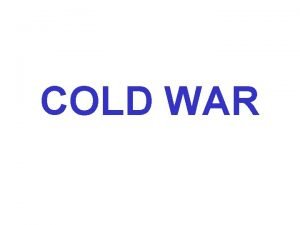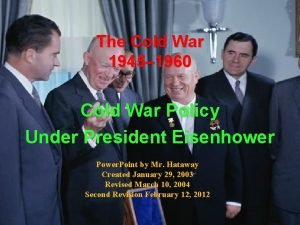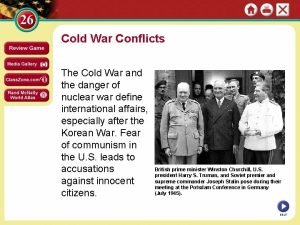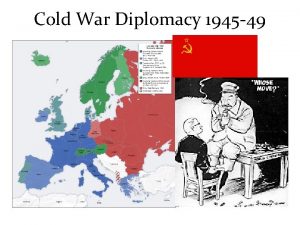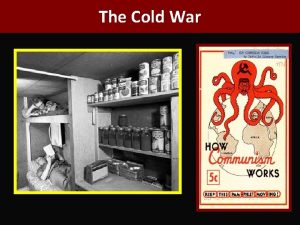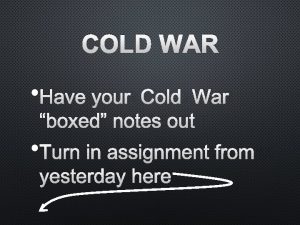Cold War SSUSH 20 SSUSH 20 Analyze US





































- Slides: 37

Cold War SSUSH 20

SSUSH 20 Analyze US international & domestic policies including their influences on technological advancements & social changes during the Truman & Eisenhower administration.

a. Analyze the international policies & actions developed as a response to the Cold War including containment, the Marshall Plan, the Truman Doctrine, and the Korean War.

Roots of Cold War: UNITED STATES: SOVIET UNION: • Capitalist democracy • Private property • Respected individual freedoms & differences • Communism • Dictatorship • Could not: – worship as they pleased – own private property – Express their views freely **Both countries differed on how to rebuild/deal with Germany after World War II.

The Cold War: 1945 -1991 • The Cold War was the era of confrontation and competition beginning immediately after WW II between the United States and the Soviet Union

Truman Doctrine • Proposed by President Harry Truman in 1947, The Truman Doctrine provided aid to any country battling Communist aggression • It was immediately used to support the free governments in Turkey and Greece against communist threats

Containment Policy • Containment – The U. S. key foreign policy towards the Soviet Union and communism – Used to block, or contain, communist expansion into other countries – NATO (North Atlantic Treaty Organization) was created to provide for the mutual defense of Western Europe from the newly atomic armed USSR

Marshall Plan: • After WW II much of Europe was devastated physically and economically • To rebuild Europe and support democratic ideas, the U. S. developed the Marshall Plan which provided billions of dollars in aid to European countries • The Soviet Union rejected the aid and developed it’s own economic program • The US gave $13. 3 billion dollars to help rebuild Europe and aided 22 European countries

Checkpoint 1 1. What do these cartoons represent? 2. What do they have to say about Cold War feelings between the US and Russia? 3. How have USRussian relations changed today?

China: • Truman Doctrine & containment were not successful in Asia • China became involved in a civil war: Nationalists vs. the Communists • The US supported the Nationalists, while the USSR supported the Communists • 1949: China became a communist country & the US became fearful that China and Russia would attempt to make all of Asia communist

Korean War: 1950 -1953 • At the end of WW II Korea was split into two at the 38 th parallel, with the Soviets occupying the north and the U. S. occupying the south • Both the North and the South formed their own governments and claimed the entire country as their own. • In 1950 the Soviet backed North Korean Army invaded South Korea nearly capturing the whole country

Korean War • The U. S. Army backed by United Nations troops, counter-attacked and pushed the North Korean Army to the border of China • Feeling threatened by the advance, China attacked and forced the U. S. to retreat back behind the 38 th parallel

Korean War • The two sides eventually signed an armistice in 1953 • The U. S. then began to build up their military and signed defense agreements with many Asian countries • The U. S. also began sending aid to French forces fighting Communist forces in Vietnam

Korean War: • Long-term effects: 1. no victory/clear winner 2. North Korea remained communist allied with China; South Korea stayed noncommunist allied with the US 3. Truman had committed US troops with no declaration of war; set a precedent that other Presidents would later follow 4. Led to increased military spending

b. Connect major domestic issues to their social effects including the G. I. Bill, Truman’s integration policies, Mc. Carthyism, the National Interstate & Defense Highway Act, & Brown v. Board of Education.

G. I. Bill: • When WWII ended, Americans were afraid that their wages would fall during peacetime • Federal government enacted the G. I. Bill that granted veterans a variety of benefits (1 year of unemployment payments, received financial aid to attend college, government loans to build homes & start businesses)

G. I. Bill: • Had huge impacts on American society • Home loans caused a huge surge in home construction • Created large growth in suburban areas • Boosted education & allowed over 8 million veterans to go to college

The Baby Boom • The baby boom, or rise in birth rates, that had begun in the 1940 s continued in the 1950 s.

Baby Boom

Suburbs, Cars, and Highways Suburban Growth Cars and Highways • The GI Bill of Rights gave returning soldiers low-income mortgages, enabling many to buy homes in newly built suburbs. • Developers such as William J. Levitt built entire communities quickly and on one mold, using preassembled materials. • Although most Americans enjoyed living in communities such as Levitt’s, others complained that the new developments lacked variety. • The growth of suburbs led more Americans to rely on cars for everyday transportation. • More and better roads were needed to support the increase in cars. The 1956 Federal-Aid Highway Act provided billions of dollars to build an interstate highway system • Cars became part of American culture as new businesses such as drive-in movies emerged.

Levittown

Interstate Highway Act

Truman’s Integration Policies • Unlike FDR, Truman refused to remain passive about segregation • Created a special committee on civil rights to investigate race relations; made several recommendations that Congress refused • Acting on his own, in 1948, he issued Executive Order 9981 to desegregate the armed forces; took place during the Korean War. • He also ordered an end to discrimination in hiring government employees. • Helped to break down stereotypes and allowed Americans to develop relationships with other races

Senator Joseph Mc. Carthy • The rise of Communism in the Soviet Union and China, and the war in Korea gave rise to a new Red Scare in the U. S. WHEN DID THE FIRST RED SCARE OCCUR? • Many Americans felt as though the U. S. was losing the Cold War battle and wanted a government explanation • In 1950 Senator Mc. Carthy claimed to have a list of 205 men working for the U. S. government who were members of the Communist Party-this claim propelled him into the American spotlight

Mc. Carthy • In 1952 Mc. Carthy began holding hearings about Communism, accusing many in the government of being spies, or Communist sympathizers • His “witch-hunt” for communist became know as Mc. Carthyism. Those who openly challenged Mc. Carthy would be accused of being a communist sympathizer

Mc. Carthy-ism • Mc. Carthy’s downfall began in 1954 when, in televised hearings, he accused the U. S. Army of containing communists • As millions of Americans watched on TV, he openly badgered and harassed witnesses • With pressure from the American people, Congress censured Mc. Carthy, ending his political power

National Interstate & Highways Act: • Passed in 1956 by Eisenhower • Because of the boom of suburban growth, there was little public transportation from the suburbs to the cities (for work) • Built over 41, 000 miles of highways were built to provide better transportation

Brown v. Board of Education (1954): • President: Dwight Eisenhower • Overturned Plessy v. Ferguson (1896) • In this case, the Supreme Court ruled that separate schools for whites and blacks were unequal – and thus unconstitutional. • Some Southern communities refused to accept the Brown decision. In 1955, the Supreme Court handed town a second Brown ruling. It ordered schools to desegregate more quickly.

Brown v. Board of Education (1954): • In 1951 in Topeka, Kansas, a parent challenged his local school board by suing on grounds of segregation • His daughter had to attend an all Black school that required her to walk a mile, even though the closest (white) school was only seven blocks away • NAACP took on the case that went all the way to the Supreme Court

• The school desegregation issue reached a crisis in 1957 in Little Rock, Arkansas. • The state’s governor refused to let 9 black students attend Little Rock Central High School. • President Eisenhower sent in federal troops to allow the students to enter the school.

• http: //www. youtube. com/watch? v=oodol. Em Ug 2 g

Checkpoint 2 1. What desegregated the military? 2. What court case overturned Plessy v. Ferguson? 3. What gave veterans a variety of benefits? 4. What was the impact of the GI Bill of Rights?

c. Examine the influence of Sputnik on US technological innovations

Sputnik: • In Oct. 1957, the Soviet Union launched the first satellite into space • The following month, they launched another satellite, this time carrying a dog onboard • The launches shocked Americans, who had long believed that they were superior in the area of technology • Americans became afraid that the Soviets could launch missiles at them from space

Sputnik: • Although President Eisenhower tried to “downplay the satellite as a ‘useless hunk of iron, ” he became anxious about keeping America ahead of all Soviet achievements. • This created an urgency to initiate a space program to get American satellites in the air (NASA).

Sputnik: • Increased a huge push for funding of math and science education in American schools • Inspired a generation of engineers & scientists to develop new technology

Checkpoint 3 • Examine. 1. Who is this man? 2. What is he doing? 3. What does this map represent? 4. Name this cartoon – explain your choice.
 Lesson 1 the cold war begins
Lesson 1 the cold war begins Proxy war cold war definition
Proxy war cold war definition Ssush
Ssush Ssush
Ssush Ssush
Ssush Ssush
Ssush Ssush
Ssush Ssush
Ssush Ssush
Ssush Analyze the ways in which the vietnam war heightened social
Analyze the ways in which the vietnam war heightened social Chapter 26 section 2 guided reading the cold war heats up
Chapter 26 section 2 guided reading the cold war heats up Unit 8: summarizing the cold war
Unit 8: summarizing the cold war The cold war intensifies
The cold war intensifies Cold war anticipation guide
Cold war anticipation guide Cold war
Cold war Cold war superpowers face off guided reading
Cold war superpowers face off guided reading Stone cold war
Stone cold war History of cold war
History of cold war Cold war
Cold war How long did the cold war last
How long did the cold war last Operation rolling thunder cold war
Operation rolling thunder cold war Iron curtain containment
Iron curtain containment Cold war mikhail gorbachev
Cold war mikhail gorbachev Cold war who was involved
Cold war who was involved The cold war
The cold war Cold war
Cold war U2
U2 The iron curtain
The iron curtain 1984 social classes
1984 social classes America confronts the post-cold war era
America confronts the post-cold war era Comunist map
Comunist map What does nato do
What does nato do Contrasting cold war terms
Contrasting cold war terms Cold war
Cold war Totalitarianism pictoword
Totalitarianism pictoword Effects of cold war
Effects of cold war Origins of the cold war
Origins of the cold war Origins of the cold war chapter 18 section 1
Origins of the cold war chapter 18 section 1


